Drawing the human figure is a timeless art, but capturing its essence in motion adds another layer of dynamism. In the realm of figure drawing, quick sketch practices, especially what we might call “Dance Drawing,” offer a unique window into understanding movement and energy. As an artist, my sketchbook becomes a laboratory for these explorations, a space where I can experiment with lines and forms to translate the fleeting beauty of human motion onto paper. This post delves into my sketchbook journey, focusing on how the concept of dance informs my approach to figure drawing and how you can explore “dance drawing” in your own artistic practice.
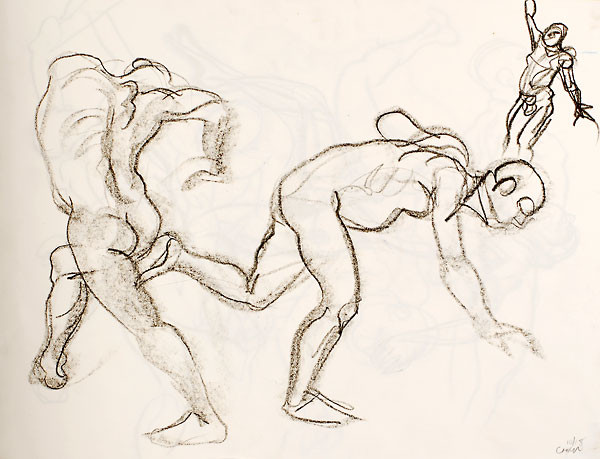 Figure drawing in crayon capturing a dynamic pose
Figure drawing in crayon capturing a dynamic pose
The Dance of Quick Poses: A Performance on Paper
For me, the practice of quick figure drawing, often done in life drawing sessions, is akin to witnessing a dance performance. These sessions, typically involving poses lasting from one to five minutes, are not about creating polished masterpieces. Instead, they are about capturing the raw energy and flow of the human form. I rarely exhibit these sketchbook pieces; they are purely for practice and exploration. Within these pages, I experiment with various media, play with scale, and even try unconventional techniques like outlining shadows as contours. The beauty of the sketchbook lies in its freedom – there’s no pressure for perfection, allowing for both successes and “crashes and burns,” as I like to call the less successful attempts.
Reflecting on past sketchbooks, particularly some larger 18″ x 24″ pads I filled in the fall of 2010, I noticed something profound. The expansive pages allowed me to capture multiple figures, creating a sense of continuous movement, one pose seamlessly flowing into the next. This effect was less pronounced in smaller sketchbooks, where poses often felt isolated on separate pages. This realization solidified my understanding of quick figure drawing as a form of “dance drawing,” where the transition between poses is as crucial as the poses themselves.
 Figure drawing capturing the energy of a model in motion
Figure drawing capturing the energy of a model in motion
Capturing Energy and Movement: Beyond Form and Structure
While precise representation of form, structure, light, and shadow in drawing is undeniably beautiful, what truly excites me is capturing the feeling of living energy and movement. This is where the concept of “dance drawing” becomes central. I view a series of quick poses not just as static forms, but as a dynamic sequence, much like movements in a dance.
Most of the sketches I create during these sessions are based on two-minute poses. In a typical set, a model executes ten two-minute poses of their own choosing. A session monitor calls “Change” at two-minute intervals, setting the rhythm for this artistic dance. It’s a performance composed not of flowing gestures, but of a series of carefully held positions, each carrying the echo of the movement before and the anticipation of the one to come.
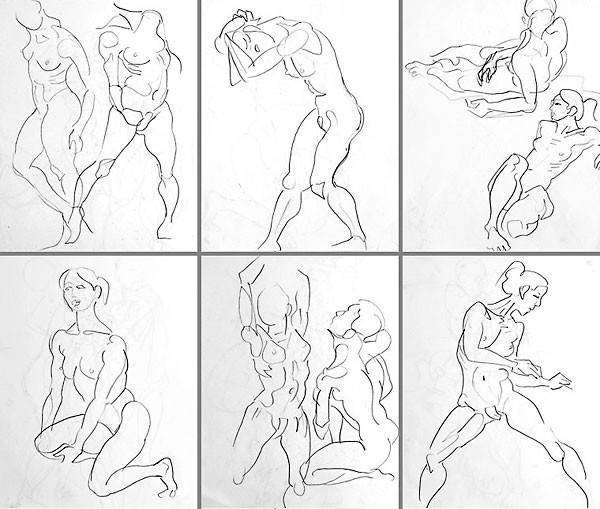 Figure drawing focused on capturing the pose and movement
Figure drawing focused on capturing the pose and movement
The Uniqueness of Models: Interpreting the Dance
The models I draw in these sessions come from diverse backgrounds. Many are dancers and actors, professions inherently linked to movement and body awareness. Others are visual artists, writers, musicians, athletes, bodyworkers, and yogis – individuals with a deep understanding of their bodies. Some even possess a more profound anatomical knowledge than many figurative artists drawing them!
This diverse pool of models brings a rich tapestry of interpretations to the “dance” of posing. Some models aim to express specific emotions, while others focus on conveying raw energy, revealing underlying structure, or exploring concepts like grounding and focus within their poses.
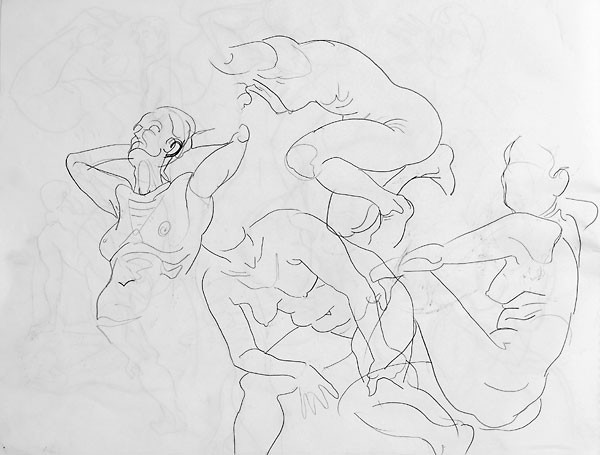 Figure drawing of a model with strong lines and form
Figure drawing of a model with strong lines and form
Focusing on Transitions: The Heart of Dynamic “Dance Drawing”
My attention is not solely fixed on the individual poses. I am even more captivated by the transitions between poses. Observing how a model moves from one position to the next reveals where energy is concentrated in the body, the push and pull that initiates the subsequent pose. The contours that express this impulse, this inherent tension, are the very lines that infuse a drawing with dynamism and life. This focus on transitional movement is key to unlocking the expressive potential of “dance drawing.”
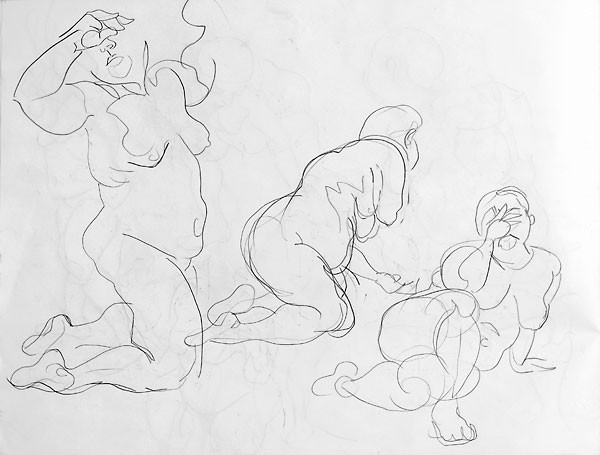 Figure drawing using contours to show movement
Figure drawing using contours to show movement
Gesture and Contour in Motion: Techniques for “Dance Drawing”
Drawing venues like Spring Studio and Figureworks Gallery, where I regularly practice, offer a fantastic range of models. Their ages span from 18 to 90, and their body types vary from slender to full-figured. This diversity extends to their personalities and approaches to modeling, each bringing a unique “dance” to their poses.
When approaching “dance drawing,” I actively seek out the characteristics that make each model unique. This involves focusing on specific curves, angles, and proportions. While some drawing instructors advocate for simplified, abstracted representations of the body, I find that excessive abstraction can lead to generic figures. For me, the goal is to be as specific as possible, capturing the individual “dance” of each model’s form.
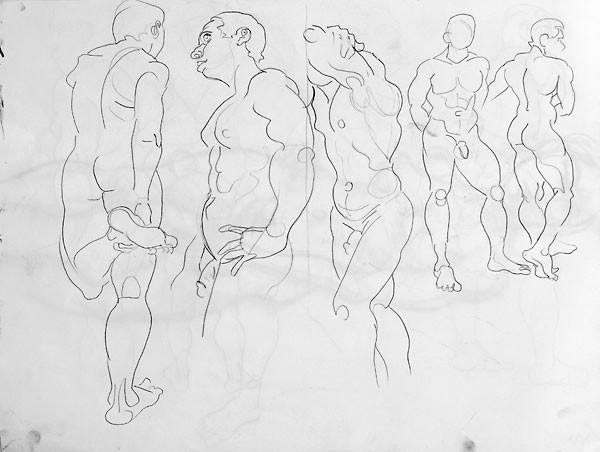 Figure drawing showing unique body proportions
Figure drawing showing unique body proportions
Sketchbook as a Dance Floor: Embracing Spontaneity
In Kimon Nicolaides’s renowned book, The Natural Way to Draw, he introduces two fundamental figure drawing exercises: spontaneous “gesture” drawing and deliberate “contour” drawing. Through practice, one realizes that every contour possesses a gestural quality, and every gestural mark inherently defines a contour. These seemingly opposing techniques converge and intertwine, becoming essential tools in “dance drawing.”
To further enhance the sense of dynamism and flow in my “dance drawings,” I often allow figures to extend beyond the edges of the page. This technique creates a feeling of unbounded energy. I prioritize capturing detail in the most dynamic areas of the pose, sometimes at the expense of meticulously rendering less crucial parts. While the overall direction of the head, hands, and feet are important for conveying expression, embracing a degree of incompleteness can actually enhance the feeling of movement in quick sketches.
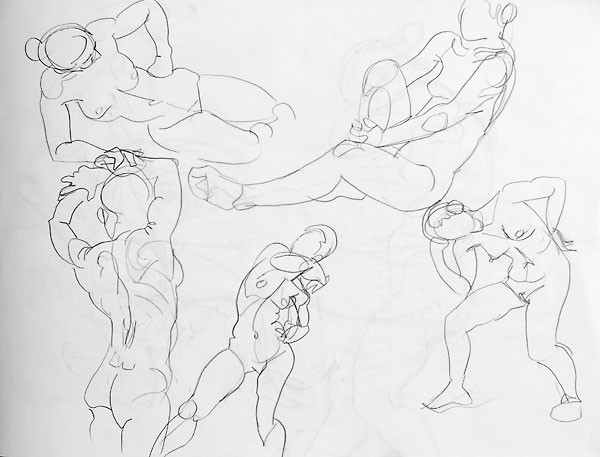 Figure drawing extending beyond the page's edge
Figure drawing extending beyond the page's edge
The Performance of Quick Poses: A Gift of Energy
Models approach quick poses in various ways. Some might enact scenes or perform actions, ranging from everyday gestures to dramatic expressions. Others might transition abruptly between entirely different poses, while some treat the sequence as a continuous flow, shifting weight and direction while maintaining a sense of connection between poses. Some models draw inspiration from art history, referencing poses seen in the works of masters like Caravaggio, Rubens, or Rodin. Others adopt casual, balanced stances, showcasing natural variations in posture. Still others push their physical limits, exploring challenging stretches and balances within the brief timeframe of a quick pose.
Poses that involve twisting or reaching often subtly shift and relax even within a minute or two. Many classic, stable poses rely on bracing one part of the body against another or against a support for sustained balance. Most models have a repertoire of frequently used poses and a consistent style that permeates a whole series of longer poses. However, when the feeling or type of pose shifts dramatically from one to the next in a quick pose sequence, the multi-pose page can resemble a scene with multiple characters rather than a continuous flow of movement.
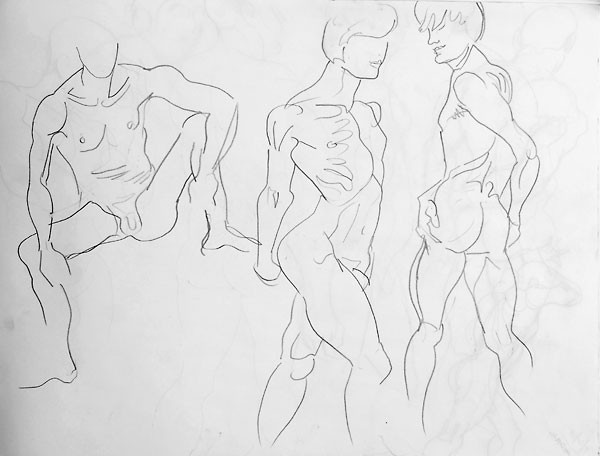 Figure drawing showing various poses on one page
Figure drawing showing various poses on one page
Ultimately, a set of quick poses often reveals more about a model’s unique character than a longer pose. It’s challenging for a model to sustain intense energy or push physical boundaries in a lengthy pose. Quick poses, in contrast, become a performance, a concentrated burst of energy gifted to the artist. As an artist, I feel compelled to reciprocate with total focus and intensity. Like the best moments in life, a quick pose, a fleeting dance of form and energy, must be savored in the present moment, for it is inherently ephemeral.
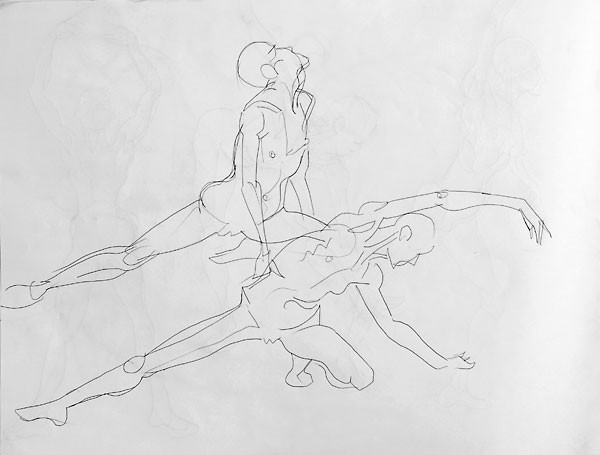 Figure drawing in pen capturing the fleeting moment
Figure drawing in pen capturing the fleeting moment
These sketchbook pages, all created between September and December 2010 and measuring 18″ x 24″, are a testament to the ongoing exploration of “dance drawing” in my practice. Unless otherwise noted, all sketches are rendered in pencil, capturing the essence of movement and energy in these fleeting moments of artistic dance.
